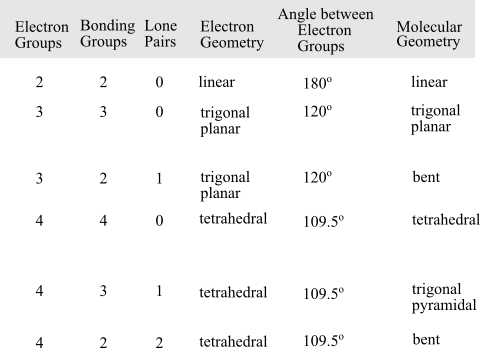
Concept explainers
Interpretation:
The molecular geometry of each of the given polyatomic ions or molecules is to be determined.
Concept Introduction: To determine the molecular geometry of a polyatomic ion, consider the total number of electron groups, the number of bonding groups and the number of lone pairs.
While writing the Lewis structure of a covalent molecule these steps are followed:
First, correct skeleton is written for the molecule
Total number of valence electrons are calculated
Distribution of a total number of valence electrons in such a way that it completes the octet configuration of all the constituent atoms.
If any atom lacks the octet configuration the double or triple bonds are added.
For molecules which obey the octet rule must have eight electrons in their valence shell. In the molecule, the total number of electron groups around the central atom is equal to the sum of lone pairs, a single bond, a double bond and triple bond around the central atom. On the basis of electron groups, the molecular geometry is predicted. To determine the geometry of the molecule, follow the following table:

Want to see the full answer?
Check out a sample textbook solution
Chapter 10 Solutions
Introductory Chemistry Plus MasteringChemistry with eText - Access Card Package (5th Edition) (New Chemistry Titles from Niva Tro)
- Please see photoarrow_forward=Naming benzene derivatives Name these organic compounds: structure C1 CH3 name ☐ CH3 ப C1 × ☐arrow_forwardBlocking Group are use to put 2 large sterically repulsive group ortho. Show the correct sequence toconnect the reagent to product with the highest yield possible. * see image **NOTE: The compound on the left is the starting point, and the compound on the right is the final product. Please show the steps in between to get from start to final, please. These are not two different compounds that need to be worked.arrow_forward
 ChemistryChemistryISBN:9781305957404Author:Steven S. Zumdahl, Susan A. Zumdahl, Donald J. DeCostePublisher:Cengage Learning
ChemistryChemistryISBN:9781305957404Author:Steven S. Zumdahl, Susan A. Zumdahl, Donald J. DeCostePublisher:Cengage Learning ChemistryChemistryISBN:9781259911156Author:Raymond Chang Dr., Jason Overby ProfessorPublisher:McGraw-Hill Education
ChemistryChemistryISBN:9781259911156Author:Raymond Chang Dr., Jason Overby ProfessorPublisher:McGraw-Hill Education Principles of Instrumental AnalysisChemistryISBN:9781305577213Author:Douglas A. Skoog, F. James Holler, Stanley R. CrouchPublisher:Cengage Learning
Principles of Instrumental AnalysisChemistryISBN:9781305577213Author:Douglas A. Skoog, F. James Holler, Stanley R. CrouchPublisher:Cengage Learning Organic ChemistryChemistryISBN:9780078021558Author:Janice Gorzynski Smith Dr.Publisher:McGraw-Hill Education
Organic ChemistryChemistryISBN:9780078021558Author:Janice Gorzynski Smith Dr.Publisher:McGraw-Hill Education Chemistry: Principles and ReactionsChemistryISBN:9781305079373Author:William L. Masterton, Cecile N. HurleyPublisher:Cengage Learning
Chemistry: Principles and ReactionsChemistryISBN:9781305079373Author:William L. Masterton, Cecile N. HurleyPublisher:Cengage Learning Elementary Principles of Chemical Processes, Bind...ChemistryISBN:9781118431221Author:Richard M. Felder, Ronald W. Rousseau, Lisa G. BullardPublisher:WILEY
Elementary Principles of Chemical Processes, Bind...ChemistryISBN:9781118431221Author:Richard M. Felder, Ronald W. Rousseau, Lisa G. BullardPublisher:WILEY





